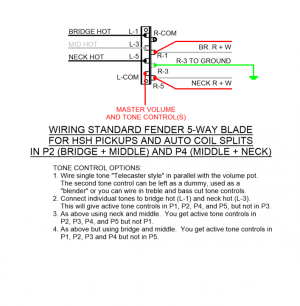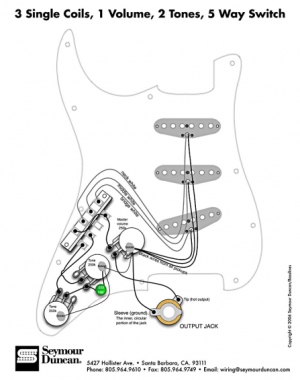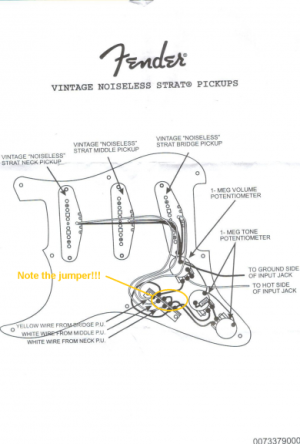ThreeChordWonder
New member
My idea, not claiming to be the first to think of it by any means, on how to do an auto coil split with a regular 5-way.
It means you'll probably have to sacrifice having a tone control on one pickup, or use a master tone Tele style, and use the spare knob for something else or just leave it as a dummy.
Wire the three hot "ins" and the "out" to the master volume to one side of the switch, normal Strat style. Now wire the two tones to two of the "ins". You can't wire one tone control to two "ins" because you'll create a jumper making both pickups active whether you like it or not. Alternatively wire it Tele style with a master volume and a master tone. The second tone could become a blender, for example, or just left as a dummy.
On the other side of the switch, connect the "middle" humbucker wires (red and white in SD pickups) to their respective "ins" at P1 and P5. Now ground the "in" P3 for the middle pickup on that side of the switch, not the hot "ins" side.
In P1 the red and whites don't connect to the middle lug. Same in P5. In P2 and P4, however, they do,, as appropriate for bridge or neck pickup.. So the red and white get grounded, so you get coil splits. In P3 theyre not grounded either, but that doesn't matter because the hot "ins" on the other side aren't connected anyway.
It means you'll probably have to sacrifice having a tone control on one pickup, or use a master tone Tele style, and use the spare knob for something else or just leave it as a dummy.
Wire the three hot "ins" and the "out" to the master volume to one side of the switch, normal Strat style. Now wire the two tones to two of the "ins". You can't wire one tone control to two "ins" because you'll create a jumper making both pickups active whether you like it or not. Alternatively wire it Tele style with a master volume and a master tone. The second tone could become a blender, for example, or just left as a dummy.
On the other side of the switch, connect the "middle" humbucker wires (red and white in SD pickups) to their respective "ins" at P1 and P5. Now ground the "in" P3 for the middle pickup on that side of the switch, not the hot "ins" side.
In P1 the red and whites don't connect to the middle lug. Same in P5. In P2 and P4, however, they do,, as appropriate for bridge or neck pickup.. So the red and white get grounded, so you get coil splits. In P3 theyre not grounded either, but that doesn't matter because the hot "ins" on the other side aren't connected anyway.
Last edited:



